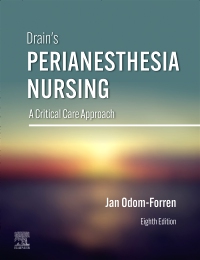
Drain's PeriAnesthesia Nursing – Elsevier eBook on VitalSource, 8th Edition
Elsevier eBook on VitalSource

Trusted for more than 30 years, Drain's PeriAnesthesia Nursing: A Critical Care Approach, 8th Edition provides comprehensive clinical content tailored specifically for perianesthesia nurses. An easy-to-use format with five distinct sections — covering the PACU, anatomy and physiology, pharmacology, nursing care, and special considerations — means students get the equivalent of five books in one. Nursing and pharmacologic interventions are integrated with in-depth coverage of pathophysiology, and updated content includes the latest standards and current issues affecting perianesthesia nursing practice. Focusing on research, documentation, and psychosocial considerations, this is the one book that can take students all the way from being a novice nurse in the PACU to preparing for CPAN® or CAPA® certification!
-
- UPDATED! Revised content throughout provides the most up-to-date information for effective perianesthesia nursing practice.
- Five separate sections provide comprehensive coverage, including the PACU, anatomy and physiology, pharmacology, nursing care, and special considerations.
- NEW! Full-color layout makes content more visually appealing and highlights important information.
- NEW! Chapter on International Care of the Perianesthesia Patient offers complete coverage on this key topic.
- NEW! Information on SARS/COVID-19 is now included in the Pathogens chapter.
- UPDATED! Coverage of pain management for the perianesthesia patient features the latest guidelines.
- UPDATED! Patient with Chronic Disorders chapter provides current information on caring for these patients.
- UPDATED! Evidence-Based Research boxes provide the latest standards of care.
- Coverage of current policies and issues affecting perianesthesia nursing practice includes patient safety, infection control, managed care implications, pain management, and bioterrorism.
- Comprehensive information on the various types of anesthetic agents familiarizes students with what will be used in the PACU.
- Special Considerations section details the care of patients with conditions such as malignant hyperthermia, substance abuse, sickle cell anemia, and cardiac arrest.
-
- UPDATED! Revised content throughout provides the most up-to-date information for effective perianesthesia nursing practice.
- NEW! Full-color layout makes content more visually appealing and highlights important information.
- NEW! Information on SARS/COVID-19 is now included in the Pathogens chapter.
- NEW! Chapter on International Care of the Perianesthesia Patient offers complete coverage on this key topic.
- UPDATED! Coverage of pain management for the perianesthesia patient features the latest guidelines.
- UPDATED! Patient with Chronic Disorders chapter provides current information on caring for these patients.
- UPDATED! Evidence-Based Research boxes provide the latest standards of care.
-
Section I: The Postanesthesia Care Unit
1. Space Planning and Basic Equipment Systems
2. Perianesthesia Nursing as a Specialty
3. Management and Policies
4. Crisis Resource Management in the PACU
5. Infection Prevention and Control in the PACU
6. The Changing Health Care System and Its Implications for the PACU
7. Patient Safety and Legal Issues in the PACU
8. Ethics in Perianesthesia Nursing
9. Evidence-Based Practice and Research
Section II: Physiologic Considerations in the PACU
10. The Nervous System
11. The Cardiovascular System
12. The Respiratory System
13. The Renal System
14. Fluid and Electrolytes
15. The Endocrine System
16. The Hepatobiliary and Gastrointestinal System
17. The Integumentary System
18. The Immune System
Section III: Concepts in Anesthetic Agents
19. Basic Principles of Pharmacology
20. Inhalation Anesthesia
21. Nonopioid Intravenous Anesthetics
22. Opioid Intravenous Anesthetics
23. Neuromuscular Blocking Agents
24. Local Anesthetics
25. Regional Anesthesia
Section IV: Nursing Care in the PACU
26. Transition from the Operating Room to the PACU
27. Assessment and Monitoring of the Perianesthesia Patient
28. Patient Education and Care of the Perianesthesia Patient
29. Postanesthesia Care Complications
30. Assessment and Management of the Airway
31. Pain Management
32. Care of the Ear, Nose, Throat, Neck, and Maxillofacial Surgical Patient
33. Care of the Ophthalmic Surgical Patient
34. Care of the Thoracic Surgical Patient
35. Care of the Cardiac Surgical Patient
36. Care of the Vascular Surgical Patient
37. Care of the Orthopedic Surgical Patient
38. Care of the Neurosurgical and Neurointerventional Patient
39. Care of the Thyroid and Parathyroid Surgical Patient
40. Care of the Gastrointestinal, Abdominal, and Anorectal Surgical Patient
41. Care of the Genitourinary Surgical Patient
42. Care of the Obstetric and Gynecological Surgical Patient
43. Care of the Breast Surgical Patient
44. Care of the Plastic and Reconstructive Surgical Patient
45. Care of the Patient Undergoing Bariatric Surgery
46. Care of the Ambulatory Surgical Patient
47. Care and the Laser/Laparoscopic Surgical Patient
Section V: Special Considerations
48. Care of the Patient with Chronic Disorders
49. Care of the Pediatric Patient
50. Care of the Older Patient
51. Care of the Pregnant Patient
52. Care of the Patient with Substance Use Disorder
53. Care of the Patient with Thermal Imbalance
54. Care of the Shock Trauma Patient
55. Care of the Intensive Care Unit Patient in the PACU
56. Bioterrorism and Its Impact on the PACU
57. Cardiopulmonary Resuscitation in the PACU
58 International Perspectives on Perienesthesia Nursing and Competence


 as described in our
as described in our 